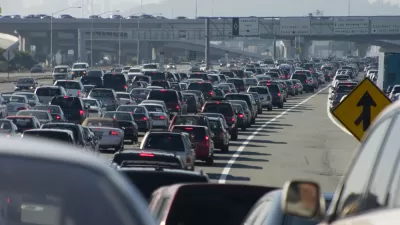Transportation demand models offer predictions that are used to make important decisions, but their accuracy is questionable. The real issue, however, might be about the goals of planning and how urban life and livability are quantified.

"Despite them being a legally required portion of any transportation infrastructure project that gets federal dollars, it is one of urban planning’s worst kept secrets that [travel demand] models are error-prone at best and fundamentally flawed at worst," writes Aaron Gordon.
Gordon says the primary issue is not so much whether these models could produce better results but rather why they are considered the best guides to make planning and policy decisions. "TDMs, its critics say, are emblematic of an antiquated planning process that optimizes for traffic flow and promotes highway construction. It’s well past time, they argue, to think differently about what we’re building for," says Gordon.
Gordon describes major issues with TDMs: assumptions about population, land-use patterns, and travel decision-making as fixed and predictable. The flip side, he says, is induced demand, where expanded roadway capacity does not relieve congestion but rather amplifies it. "To fully appreciate the absurdity of this quest, look no further than the $2.8 billion freeway project in Katy, Texas that was supposed to reduce commute times along the expanded 23-lane freeway, the widest in the world. All too predictably, congestion only increased, and commute times are longer still."
TDM critics say the focus should be on different measures that reflect quality-of-life issues such as access to public transit, parks, and walkable neighborhoods. “The question is not whether the predictions of how they will behave are accurate, but what kind of behavior we want to have more of,” adds Gordon.
FULL STORY: The Broken Algorithm That Poisoned American Transportation

Planetizen Federal Action Tracker
A weekly monitor of how Trump’s orders and actions are impacting planners and planning in America.

San Francisco's School District Spent $105M To Build Affordable Housing for Teachers — And That's Just the Beginning
SFUSD joins a growing list of school districts using their land holdings to address housing affordability challenges faced by their own employees.

The Tiny, Adorable $7,000 Car Turning Japan Onto EVs
The single seat Mibot charges from a regular plug as quickly as an iPad, and is about half the price of an average EV.

Seattle's Plan for Adopting Driverless Cars
Equity, safety, accessibility and affordability are front of mind as the city prepares for robotaxis and other autonomous vehicles.

As Trump Phases Out FEMA, Is It Time to Flee the Floodplains?
With less federal funding available for disaster relief efforts, the need to relocate at-risk communities is more urgent than ever.

With Protected Lanes, 460% More People Commute by Bike
For those needing more ammo, more data proving what we already knew is here.
Urban Design for Planners 1: Software Tools
This six-course series explores essential urban design concepts using open source software and equips planners with the tools they need to participate fully in the urban design process.
Planning for Universal Design
Learn the tools for implementing Universal Design in planning regulations.
Smith Gee Studio
City of Charlotte
City of Camden Redevelopment Agency
City of Astoria
Transportation Research & Education Center (TREC) at Portland State University
US High Speed Rail Association
City of Camden Redevelopment Agency
Municipality of Princeton (NJ)





























